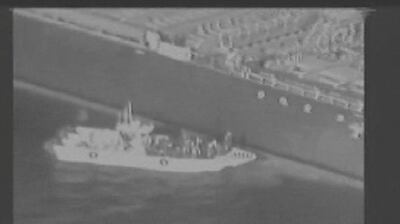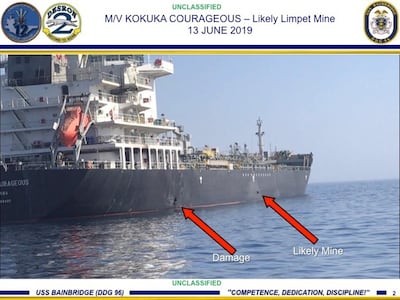After the latest attack on tankers in the Gulf of Oman, the United States military released a video they say shows Iranian sailors removing an unexploded weapon called a limpet mine from the hull of one of the ships.
The grainy footage is hard to make out but it appears to show a small craft, not unlike those employed by the Iranian Revolutionary Guard’s Quds Forces, removing an object stuck above the water line on the hull of one of the vessels hit.
In the absence of a full investigation, there has been a lot of debate about what the video exactly shows, whether the device is a limpet mine and what the men on the boat are doing.

But what is a limpet mine?
In essence, it is an explosive device that can be stuck to a ship and then detonated. It is designed to be used by frogmen or swimmers who approach an enemy vessel from below and then affix the bomb to the underside of the ship. It will have a timer or a trigger so it will detonate when the divers are a safe distance away. The bomb gets its name from, you guessed it, the small molluscs that stick themselves to rocks.
How do they work?
There are numerous variations of limpet mines employed over the last several decades but modern ones usually use magnets to stick to the side of a ship. Once the diver has attached their charge, they can set the timer, usually delayed by a mechanical or chemical fuse. Some include a secondary anti-tamper mechanism to make them harder to remove.
Most are not designed to destroy the ship, the relatively small explosives – the swimmers need to be able to carry the devices some distance – are intended to be placed in critical locations that will disable rather than sink the vessel. These include the rudder, propellers, shafts and anything else that lies below the water and the ship needs to move.
But they have also been used to scupper a ship by blowing a hole in the side. However, the issue here for military targets is that warships are, by design, meant to withstand battle at sea and their armoured hulls are hard to penetrate. By contrast, the impact on a commercial vessel, such as a tanker or cargo ship, can be significant.

What can ships do about limpets?
Military harbours will often have access restrictions or cordons and measures to enforce them, such as anti-diver netting, infrared or ultrasound detectors.
Most navies also keep lookouts on deck, checking for signs that divers are approaching the vessel underwater. If they believe they spot something, US Navy personnel are reportedly authorised to drop a concussion grenade into the water. These cause a sound wave that on land will disorientate a person but underwater can kill a nearby diver.
Then they call an Explosive Ordinance Disposal (EOD) team. These EOD divers will then check the underside of the vessel for any sign of a device. The US has teams permanently stationed in Bahrain and will have them available onboard the USS Lincoln that was recently sent to the Arabian Gulf. Many countries also restrict the sale of the kind of equipment someone would need to be able to build and then carry out an underwater mission of this kind – this makes such attacks mostly a state-operated raid.
Otherwise, especially on commercial rather than military vessels, it is generally quite hard to stop if your ship is stationary, but a moving target is harder to catch and affix the explosive. The US says the mines they blame for the latest incident were above the water, but if this is the case they could have been attached from a ship that pulled alongside while the tankers were moving – but details of the incident are still not clear.

How do you get a limpet mine off a ship?
With difficulty is the answer but naval EOD units train and practise such operations so they should have the skills if it’s needed.
But one thing most experts seem to agree about the video shared by the US is that sending a small boat laden with people alongside to whip off the device – if it is indeed an explosive – is generally not best practice.
With any explosive device, EOD units only approach with extreme caution. Even relatively simple devices could still explode unexpectedly and by minimizing direct contact and the number of people in the blast zone, you minimize the risk of more people dying if it does.
Any famous cases of limpet mines being used?
Yes, several. But not many are from the last few decades – and they’re not as well used as movies might have you believe.
In one famous raid during World War II, an allied Z Special Forces unit – a combination of British, Australian, New Zealand, Indonesian, South African, Dutch, Indonesian and Timorese soldiers trained in covert attacks behind enemy lines – sunk six Japanese ships in 1943 while they were in Singapore harbour.
Sneaking in on a converted Japanese fishing vessel, they paddled into the harbour and then placed the mines on tankers and cargo ships. The incident took the Japanese by surprise and they ruled out a foreign attack as so implausible that instead, they blamed local saboteurs.
More recently, French overseas intelligence force used a limpet mine to sink the Greenpeace Rainbow Warrior – used most famously by the activists to disrupt commercial whaling – in while in port in Auckland in 1985, killing one person. The scandal eventually led to the resignation of French Defense Minister Charles Hernu.






